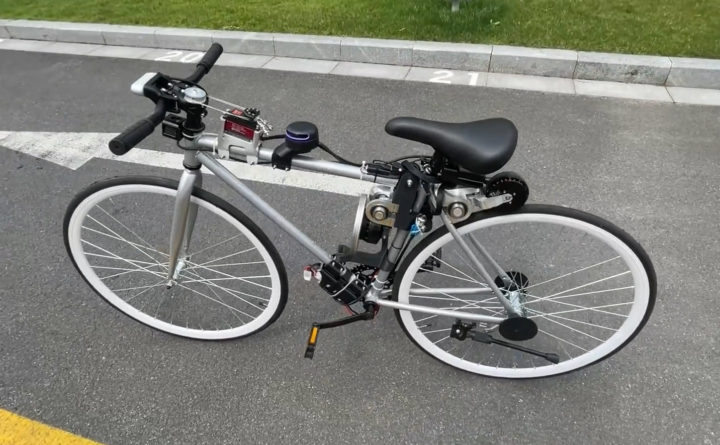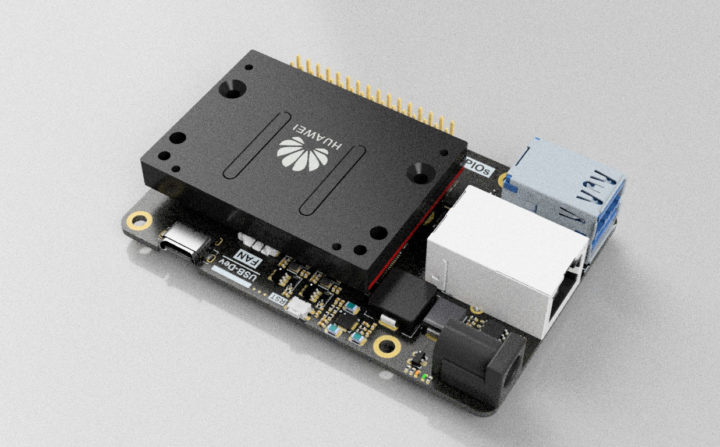After Huawei engineer Peng Zhihui Jun fell off this bicycle, he decided he should create a self-balancing, self-riding bicycle, and ultimately this gave birth to the XUAN-Bike, with XUAN standing for eXtremely, Unnatural Auto-Navigation, and also happening to be an old Chinese name for cars.
The bicycle relies on a flywheel and a control board with ESP32 and MPU6050 IMU for stabilization connected over a CAN bus to the motors, as well as Atlas 200 DK AI Developer Kit equipped with the 22 TOPS Huawei Ascend A310 AI processor consuming under 8W connected to a 3D depth camera and motor for self-riding.

It’s not the first time we see this type of bicycle or even motorcycle, but the XUAN-Bike design is also fairly well-documented with the hardware design (electronics + 3D Fusion360 CAD files) and some documentation in Chinese uploaded to Github.
The software part has not been released so far “because the coupling of the FOC drive is not universal”, but Peng promise to release a simplified version of the bicycle complete solution using a small DC motor including the source code later on. He also plans to release a Robot Embedded Development Framework (REF) that abstracts some commonly used tools and development models in robot development.

The electric bicycle is fitted with a Lithium-Ion battery that’s good for 2 or 3 hours. That would be without a rider, as all demos below are made without a “passenger” since the flywheel would not be able to balance that much extra weight.
The video explains it all in Chinese, but the machine-translated? English subtitles do help get a better grasp of the design.

Jean-Luc started CNX Software in 2010 as a part-time endeavor, before quitting his job as a software engineering manager, and starting to write daily news, and reviews full time later in 2011.
Support CNX Software! Donate via cryptocurrencies, become a Patron on Patreon, or purchase goods on Amazon or Aliexpress. We also use affiliate links in articles to earn commissions if you make a purchase after clicking on those links.





Impressive task for a man only. Wow.
Great work! I don’t find it very useful for end users but the author certainly learned a lot and this alone could bring him a pleasant job in robotics or automated vehicles.
Would be great to see a future unmanned XUAN Mk IV compete on a stage of the Tour de France as an experiment.
Also given that a human on a bicycle is the most energy efficient animal for distance and given that bicycles can go where cars and trucks can’t this could have an actual commercial application, e.g. delivery in cities.
This video has been around for a while. It’s very impressive work. It seems to really heavily focus on the hardware side of things but the most impressive part for me is the sensor fusion and control system. The explanation is a bit hand wavey “ROS + tweaking some parameters”. Is this stuff pretty turn-key now a days?
I wonder if it’d scale up to handle a moving jiggling human rider
This maybe a interesting technology play about with toys, but it is a over complex solution for simple problems.
Stability build a Tricycle, Quad bike or fit Stabilizers. Less maintenance and no battery needs. Also no electrical generation for mains charging etc needed.
Tricycles are a nightmare to transport either on public transportation or mounted to a vehicle. Tricycles are also less stable going sideways and tricycles would be lower to the ground which is a nightmare for navigating roads. Quad bicycles make things even more difficult.
Two wheels simply provides options we don’t have with 3 or 4 wheels which is why we still have two wheelers in a four wheel world.
You clarified well. Keeping things simple and focused to the aim would be next era tech motto. Tech produce many waste. Batteries harm the earth much more.
I worked for 4 years as a bicycle mechanic in a shop that services everything from penny-farthings to gravity / fat / cross / hybrid ebikes featuring CVT and 12-shift orbital transmissions.
This concept ignores a great deal of wisdom which has been learned over the history of bicycle building.
If you want to balance a bike, keep the wheels spinning. When the wheels are stopping, put your feet down. As a rider you need to learn that. Adding a generator to power a NASA-style reaction motor slows you down more than training wheels. A reaction wheel turned 90 degrees laterally to the frame will require an unlimited acceleration budget to work. At some point it hits its top speed limit and it’s like the floor dropped away from beneath you, which is super dangerous.
The best way to implement it would have been to have a flywheel within the front wheel which keeps spinning when you’ve stopped. Better yet, find a way to transfer and store the forward momentum in that flywheel under braking. Bonus points for restoring that stored forward momentum when the brakes are released! Then procession would work to turn the wheel to keep the bicycle under the rider’s centre of gravity, which is why a bicycle works in the first place. That would be a purely mechanical hybrid and you could actually make money selling it lol.
While an inline flywheel can work well for damping the system from sudden effects, it is unable to bring it out of an unstable position. Such work is usually done by a human rider, but as there isn’t one in this case, having a lateral reaction wheel is almost the only solution. After getting up to speed, the reaction wheel can then exploit the gyroscopic effects of wheels and gradually spin down, reducing the likelihood of hitting a speed wall.